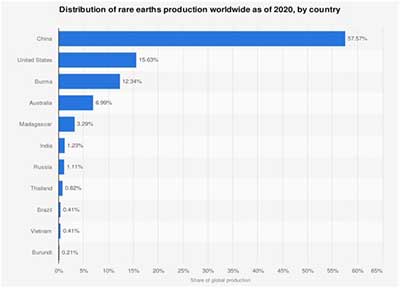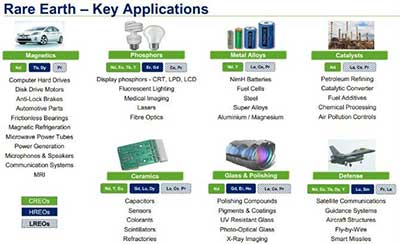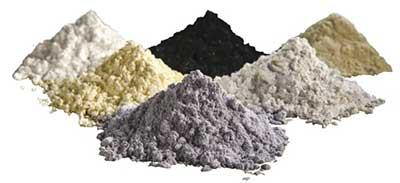Relevance: GS-3: Distribution of key natural resources across the world, Indian Economy, mobilization of resources.
Key phrases: REE, Department Of Atomic Energy, Atomic Mineral Concession Act (2016), DRE, IREL.
Why in News?
- Since the outbreak of Covid pandemic, supply chain resilience has gained prominence. Recent chip shortage that severely affected the global supply chain of several high tech products further has hastened urge for supply chain diversification of key inputs and Rare Earth Elements (REE) are on the top priority.
What is the Rare Earth Elements?
- The rare-earth elements (REE), also called the rare-earth metals or (in context) rare-earth oxides, or the lanthanides.
- The rare earth elements (REE) are a set of seventeen metallic elements. These include the fifteen lanthanides on the periodic table (cerium (Ce), dysprosium (Dy), erbium (Er), europium (Eu), gadolinium (Gd), holmium (Ho), lanthanum (La), lutetium (Lu), neodymium (Nd), praseodymium (Pr), promethium (Pm), samarium (Sm), , terbium (Tb), thulium (Tm), and ytterbium (Yb)) plus scandium and yttrium.
Rare Earth Elements production in India:
- India is endowed with rich REE reserves. With almost 7 million tonnes of REE reserve, India accounts for more than 5 per cent of global REE reserves, fifth largest in the world. India started efforts to develop domestic REE production capacity in 1950s, when it established the Indian Rare Earth Ltd (IREL) for mining and processing of REE.
- India has twice the REE reserves of Australia and therefore has great potential to partner with global tech leaders.
- Nonetheless, in spite of rich reserves and an early start, India has not been able to develop the REE industry and its share in global REE market has remained negligible.
- Consequently, for years, REE production in India remained stagnant at around 2,000 tonnes before increasing to 4,215 tonnes in 2018-19.

Production of Rare Earth Elements in World:
- In 2018, global REE reserves were estimated to be around 132 million tonnes, spread across several countries with China, Brazil, Russia and Vietnam having the biggest reservoirs. However, mining and processing of REE is quite complex, energy intensive and produces radioactive waste. Given this, only few countries have been able to develop REE industry.
- Initially, mining and processing of REE was concentrated in the US. However, with growing environmental concerns, REE mining and processing started shifting to China in early 1990s, which used lax environmental regulations along with other fiscal incentives to establish a near monopoly on REE supply chain, especially in metal refining segment.

Application of Rare Earth Elements:
- REE are crucial inputs for all high tech innovations of recent times including hybrid vehicles, cell phones, silicon chips, high strength magnets, next generation rechargeable batteries, biofuel catalysts, advance lesser guided system etc. and their global supply has remained extremely concentrated.
- The REE are essential raw materials for a wide range of applications, including metallurgy (metal refining and metal alloying), catalysts in the automotive and the petro-chemical industry, colouring of glass/ceramics, phosphors (LEDs, compact fluorescent lamps, flat panel displays), lasers, rechargeable solid state batteries (Ni-MH), fibre optics and others.

Reason for low Rare Earth Elements production in India:
- India’s inability to realise REE potential can mainly be attributed to passive government attitude.
- REE exploration and processing is fraught with financial, technological and environmental challenges and therefore needs government support in terms of clear policy and financial handholding in the initial phase of development.
- However, in spite recognising the importance of REE, the government failed to devise a clear policy or road map for the development of REE sector.
- Instead of having a separate policy for REE, government clubbed REE with atomic minerals which ensured state monopoly and kept the foreign and private domestic investors away, leading to a stagnant REE sector.
- Focus on few rare earth element: Ironically, IREL, which was established to produce REE, never actually focused on REE production. Instead, IREL gave more importance to thorium and other minerals such as ilmenite, zircon, rutile etc.
Steps for boosting REE industry in India:
- India should urgently chalk out a clear policy for REE sector with realistic objectives.
- Monopoly Abolished: India should amend Atomic Mineral Concession Act (2016) which has reserved all beach Sand Mines deposits containing more than 0.75 per cent Monazite (source of REE) for government owned companies.
- Department for rare earths (DRE) could secure access to REEs of strategic importance by offering viability gap funding to companies to set up facilities in the upstream sector. This could make Indian REOs globally competitive.
- The DRE will then look at deregulation of this sector and will also promote R&D in the field. Its sole focus will be on ramping up India’s REE production and make India a part of the global supply chain. For this purpose supervision of IREL should also be shifted from the department of atomic energy (DEA) to the DRE, and its primary remit needs to change from atomic minerals to rare earths.
- There is also a need to look at introducing more players in the value chain and opening it up for investments. While private investments alone may not be able to suffice the upstream processing which require an enormous amount of capital investment and government financing. It is the downstream processes where a public-private approach can help attract investment and purchasers as more efficient processes are put in place.
- Governent should also create an autonomous regulator, the Rare Earths Regulatory Authority of India (RRAI), to resolve disputes between companies in this space and check compliance.
- Finally, it could coordinate with other agencies to partner directly with groupings such as the Quad, building up a strategic reserve as a buffer against global supply crises.
Way forward:
- Development of upstream REE industry can potentially be a boon for India. Chinese experience show that availability of REE supply can be a very effective tool to attract foreign direct investment in high tech manufacturing sector which use REE as input.
- India too can leverage REE reserves to stimulate economically more valuable downstream high tech manufacturing to achieve the target of Atamnirbhar Bharat.
Source: The Hindu BL
Mains Question:
Q .The world is in search of alternative supply chains. India with its reserves in rare earth elements must leverage this, in this context discuss the importance of Rare Earth Material. What should be the steps for boosting Rare Earth Material industry in India? Illustrate.







